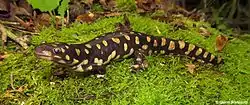Ambystomatidae
Ambystomatidae is a family of salamanders belonging to the order Caudata in the class Amphibia. It contains only one genus, Ambystoma, the mole salamanders. These salamanders are mostly terrestrial and eat invertebrates, although some species are known to eat smaller salamanders. They can be found throughout the US and some areas of Canada in damp forests or plains. This family contains some of the largest terrestrial salamanders in the world, the Tiger salamander and the Pacific giant salamander. Some species are toxic and can secrete poison from their bodies as protection against predators or infraspecific competition. Neoteny has been observed in several species in Ambystomatidae, and some of them like the Axolotl live all of their lives under water in their larval stage.
| Ambystomatidae | |
|---|---|
 | |
| Tiger Salamander | |
| Scientific classification | |
| Kingdom: | Animalia |
| Phylum: | Chordata |
| Class: | Amphibia |
| Order: | Urodela |
| Suborder: | Salamandroidea |
| Family: | Ambystomatidae |
| Genera | |
Taxonomy
The genus Rhyacotriton was formerly included in this family, but is now usually placed into its own family Rhyacotritonidae. In 2006, a large study of amphibian systematics (Frost et al., Bulletin of the American Museum of Natural History, 297 (2006) placed Dicamptodon back within Ambystomatidae, based on cladistic analysis. This has been accepted by the Center for North American Herpetology.
External links
![]() Data related to Ambystomatidae at Wikispecies
Data related to Ambystomatidae at Wikispecies
![]() Media related to Ambystomatidae at Wikimedia Commons
Media related to Ambystomatidae at Wikimedia Commons
